Last updated on July 4th, 2024 at 11:39 pm
Tablecloths are a necessary part of any well-dressed table, and this Charming Quilted Square Tablecloth Pattern is the perfect way to dress up any tabletop. This easy quilting project is perfect for beginners, and with a little bit of time and effort, you can create a beautiful tablecloth that will be sure to impress your friends and family.
The finished tablecloth is reversible, so you can choose which side you want to show off. You’ll need basic sewing skills and some patience, but the results are worth it.
Fabric Scrap Table Centerpiece
I happened to have this fabric gifted to me. The pink and blue striped fabric is pretty when paired with the flower fabric.
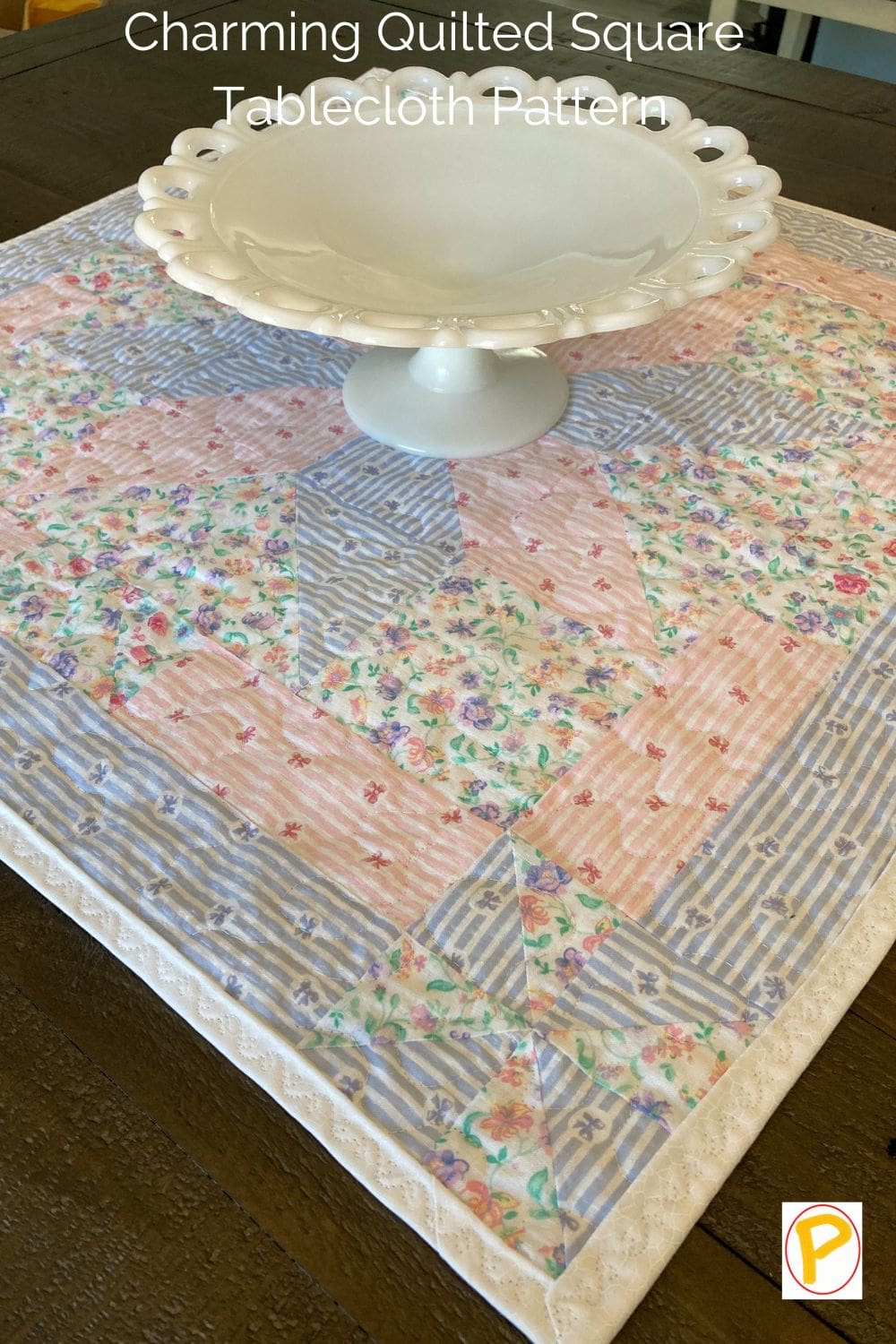
Post contains affiliate links, and we earn commissions if you shop through the links on this page. For more information, please read the disclosure section under the About Us page.
Actually, I ended up making five mini quilt patterns out of this fabric, as well as this larger 24 x 24-inch square quilt. The pastel colors will be perfect as a DIY table decoration.
This is one of my baby shower ideas on a budget. The smaller pink and blue quilted blocks can be used as a trivet too. Later, the larger tablecloth can be used as a mat to lay the baby on.
General Sewing Directions
The directions for this Charming Quilted Square Tablecloth Pattern
are for rotary cutting, machine piecing, machine quilting, machine sewing the binding to the quilt top and binding.
Pin pieces before sewing them together to help align seams.
Accurately measure and cut fabric pieces as it will enhance the finished tablecloth.
All seams are sewn with 1/4 inch seam allowance.
Seams can be pressed open. However, if you prefer to press seams to one side or the other, I will have those suggestions within the instructions.
The beginning measurements for the half square triangles are a bit larger than the finished block size needed. I like to make them a bit larger because the result is a crisp and clean edge. This helps align all the seams and points better.
Finished Size
The finished tablecloth is 24” X 24” square.
Fabric Requirements
I suggest using 100% cotton quality fabric. For some of the sizes, you could get a fat quarter and have some fabric leftover for your next quilt project.
Fabric Preparation. I suggest using a cutting mat, quilting ruler, and a rotary cutter to prepare the fabric pieces.
Pink Flower Fabric 1/4 yard.
Purple Flower Fabric 1/2 yard.
Blue Fabric 3/4 yard.
Pink Fabric 3/4 yard.
Backing fabric partial yard. One single piece measuring 28” X 28”.
Batting. A piece measuring 28” X 28”, the same size as the quilt back. This will allow the batting to also extend beyond the edges of the tablecloth top.
Thread. I suggest a good quality quilting thread for sewing the tablecloth quilt top and quilting the pieces together.
Let’s Begin the Charming Quilted Square Tablecloth
Flower and Blue White Pinwheel Block
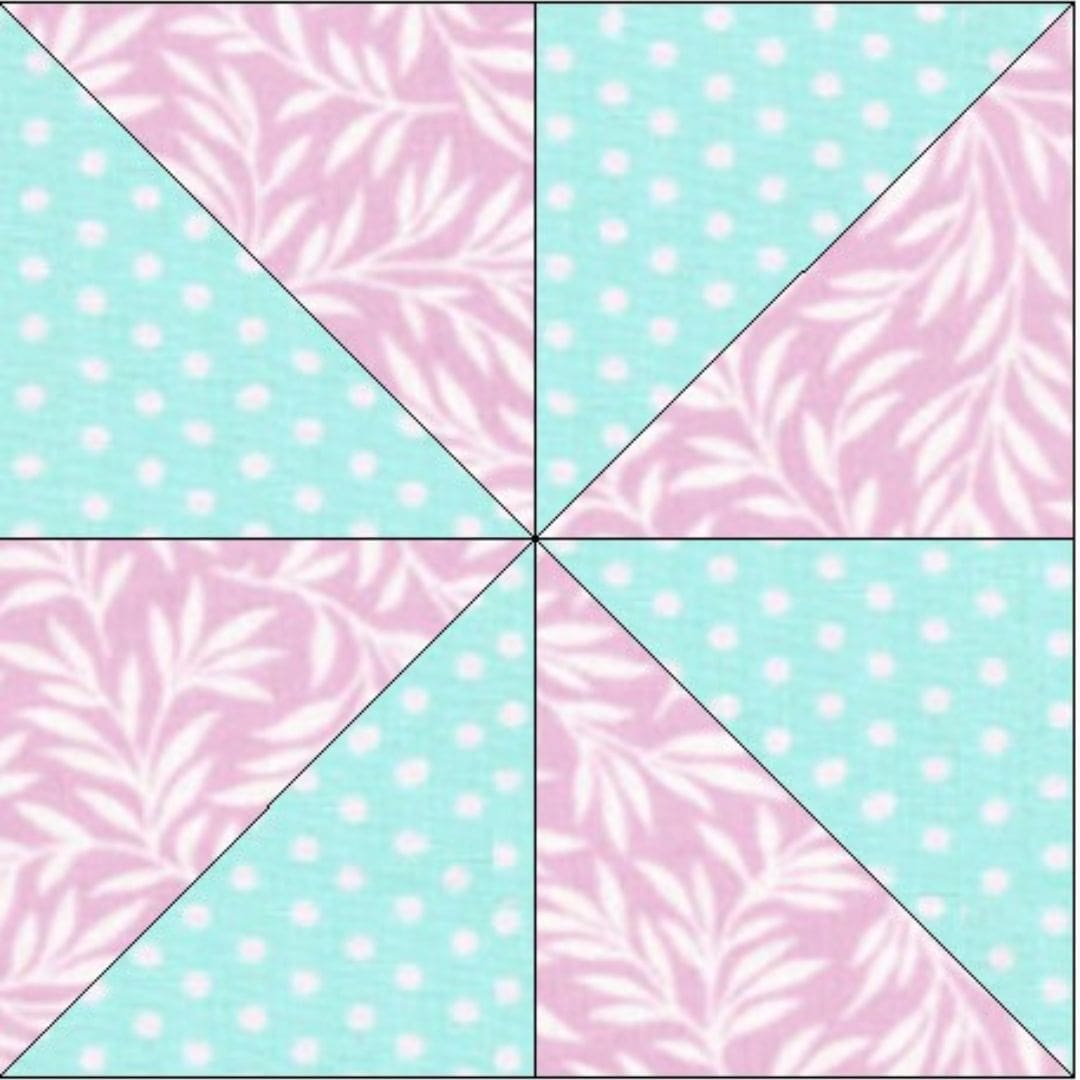
- Blue Fabric Cut 8 – 3 7/8” X 3 7/8” squares.
- Purple Flower Fabric Cut 8 – 3 7/8” X 3 7/8” squares.
Sew the Pinwheel
Use a fine pencil to draw a diagonal line on the wrong side of the 3 7/8” X 3 7/8” purple flower fabric squares.
Place a purple flower fabric square on top of a blue square with right sides together and sew 1/4” seam on both sides of the diagonal line. Align a ruler with the pencil line and cut the fabric apart on the drawn line to create two half square triangles.
Repeat for the other 7 – purple flower 3 7/8” X 3 7/8” squares and 7 – blue 3 7/8” X 3 7/8” squares.
Press each half square triangle toward the darker side or press the seams open. Trim the half square triangle blocks to measure 2 1/2 X 2 1/2.
Lay out the half square triangles to form the pinwheel design.
Sew the top two blocks with the right sides together. Press seam to the right or open. Sew the bottom two blocks with the right sides together. Press seam to the left.
Sew the top and bottom row with the right sides together, making sure to line up the seams. Press the seams open.
Trim to 4 1/2″ X 4 1/2″ Square if needed. (Repeat the steps until all 4 Pinwheel Blocks are sewn).
Star Block Frame Panels

- Purple Flower Fabric Cut 4 – 3 7/8” X 3 7/8” squares.
- Pink Flower Fabric Cut 4 – 3 7/8” X 3 7/8” squares.
- Blue Flower Fabric Cut 8 – 2 1/2″ X 16 1/2″ rectangles.
- Pink Fabric Cut 16 – 2 1/2″ X 6 1/2″ rectangles.
Sew the Panel
Use a fine pencil to draw a diagonal line on the wrong side of the 3 7/8” X 3 7/8” purple flower squares.
Place a purple flower square on top of a pink flower square with right sides together and sew 1/4” seam on both sides of the diagonal line. Align a ruler with the pencil line and cut the fabric apart on the drawn line to create two half square triangles.
Repeat for the other 3 purple flower 3 7/8” X 3 7/8” squares and 3 pink flower 3 7/8” X 3 7/8” squares.
Press each half square triangle toward the darker side or press the seam open. Trim the half square triangle blocks to measure 2 1/2 X 2 1/2.
Lay out the half square triangles to form the triangle as shown in the diagram.
Sew the two blocks with the right sides together with 1/4″ seam allowance. Press seam to the right or open.
Place a pink 2 1/2″ X 6 1/2″ rectangle on each side of the purple flower and pink flower rectangle. Sew the right sides together with 1/4″ seam allowance.
Press the seams to the outside or open. Trim this strip as needed to measure 2 1/2″ X 16 1/2″.
Place a blue 2 1/2″ X 16 1/2″ rectangle on top of the pink strip. Sew the right sides together with 1/4″ seam allowance. (See the photo to help with placement).
Press the seams to the blue fabric or open. (Repeat the steps until all 4 Star Block Panels are Sewn).
Pastel Star Block
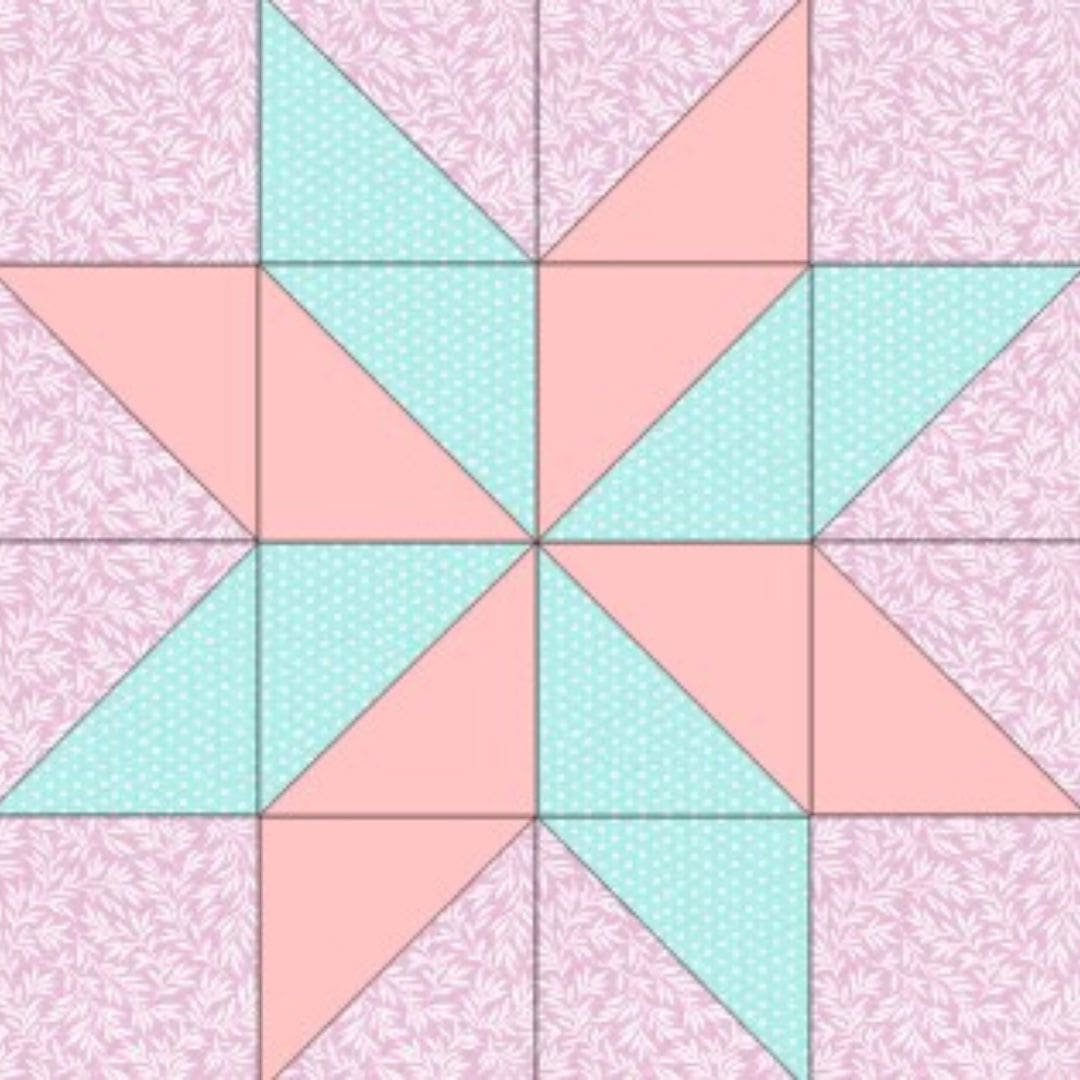
- Pink Fabric Cut 4 – 5 7/8” X 5 7/8” squares.
- Blue Fabric Cut 4 – 5 7/8” X 5 7/8” squares.
- Purple Flower Fabric Cut 4 – 5 7/8” X 5 7/8” squares.
- Purple Flower Fabric Cut 4 – 4 1/2″ X 4 1/2″ squares.
Sew the Star Block
Use a fine pencil to draw a diagonal line on the wrong side of the 4 pink 5 7/8” X 5 7/8” squares.
Place a pink5 7/8” X 5 7/8” square on top of a blue 5 7/8” X 5 7/8” square with right sides together and sew 1/4” seam on both sides of the diagonal line. Align a ruler with the pencil line and cut the fabric apart on the drawn line to create two half square triangles.
Repeat.
Place a pink5 7/8” X 5 7/8” square on top of a purple flower 5 7/8” X 5 7/8” squarewith right sides together and sew 1/4” seam on both sides of the diagonal line. Align a ruler with the pencil line and cut the fabric apart on the drawn line to create two half square triangles.
Repeat.
Use a fine pencil to draw a diagonal line on the wrong side of the two remaining 5 7/8” X 5 7/8” purple flower squares.
Place a purple flower 5 7/8” X 5 7/8” square on top of a blue 5 7/8” X 5 7/8” square with right sides together and sew 1/4” seam on both sides of the diagonal line. Align a ruler with the pencil line and cut the fabric apart on the drawn line to create two half square triangles.
Repeat.
Press each half square triangle seam open. Trim the half square triangle blocks to measure 4 1/2 X 4 1/2.
Assembling and Sewing the Star Block
Lay out the half square triangle blocks to form the pinwheel design. Next add the purple flower 4 1/2 X 4 1/2 squares in each corner. Finally add the pink and purple flower and the blue and purple flower on each side of the pinwheel. (See the photo to help with placement).
Sew the top blocks with the right sides together with 1/4″ seam allowance. Press seam to the right or open. Sew the next row of blocks with the right sides together with 1/4″ seam allowance. Press seam to the left or open.
Sew the third row of blocks together and press the seam to the right or open. Finally sew the bottom row of blocks together and press the seams to the left or open.
Place the top two rows with the right sides together aligning the center seams. Pin in place and sew the rows together. Press the seam open.
Place the bottom two rows with the right sides together aligning the center seams. Pin in place and sew the rows together. Press the seam open.
Finally, pin the top and bottom halves with the right sides together aligning the center seams. Pin in place and sew the rows together. Press the seam open.
Trim the block, if necessary, to measure 16 1/2″ X 16 1/2″ Square.
Block Assembly
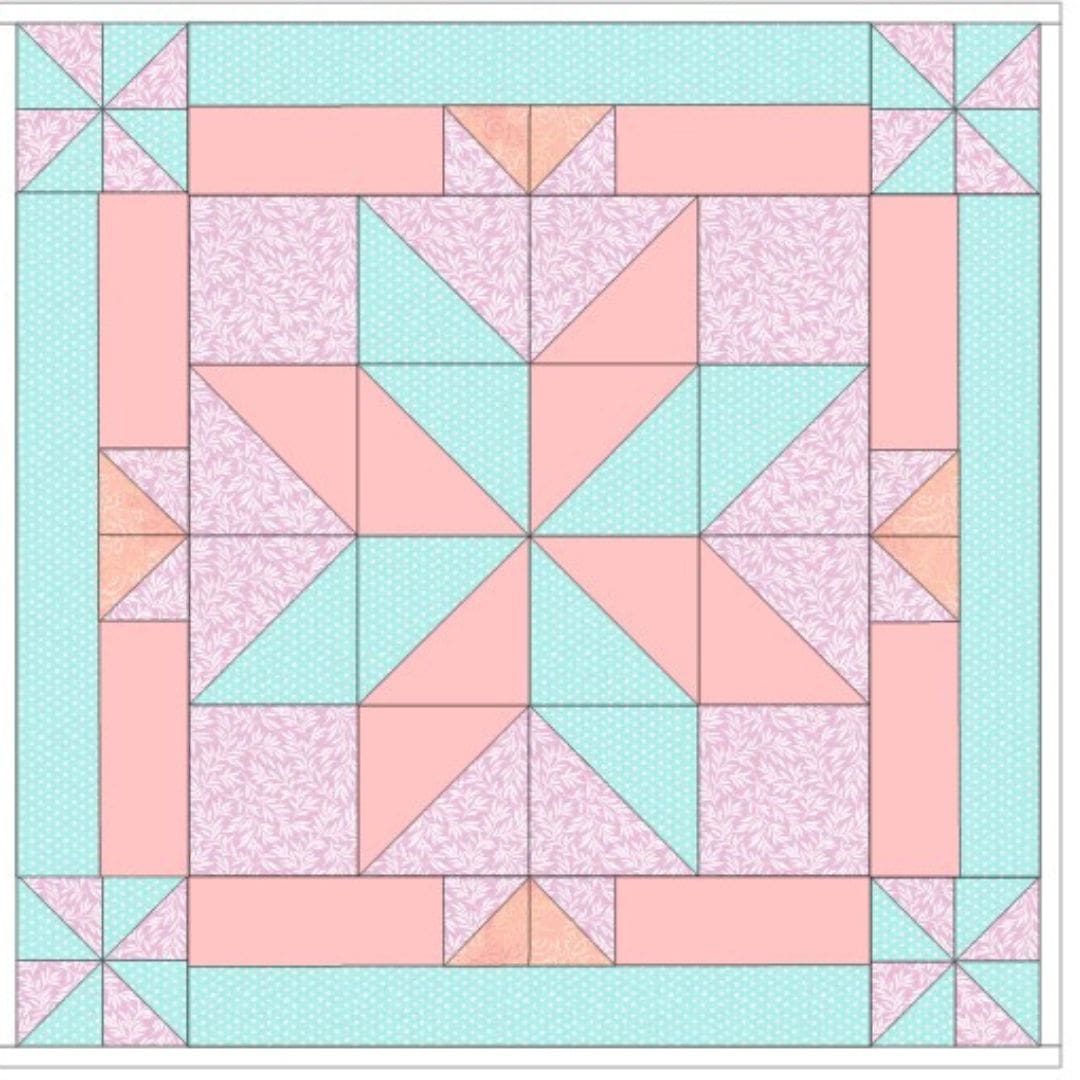
Arrange a star block frame panel on all four sides of the star block.
Place a blue and purple flower pinwheel block in each corner.
With the right sides together, sew a star block frame panel on the sides of the star block using 1/4″ seam allowance. Press the seams to the outside or open.
With the right sides together, sew a blue and purple flower pinwheel block on the left and right of the top star block frame panel and bottom star block frame panel, using 1/4″ seam allowance. Press the seams to the inside or open.
With the right sides together, sew the top and bottom panels on star block using 1/4″ seam allowance. Press the seam to the outside or open.
Trim the block to measure 24″ X 24″ if needed.
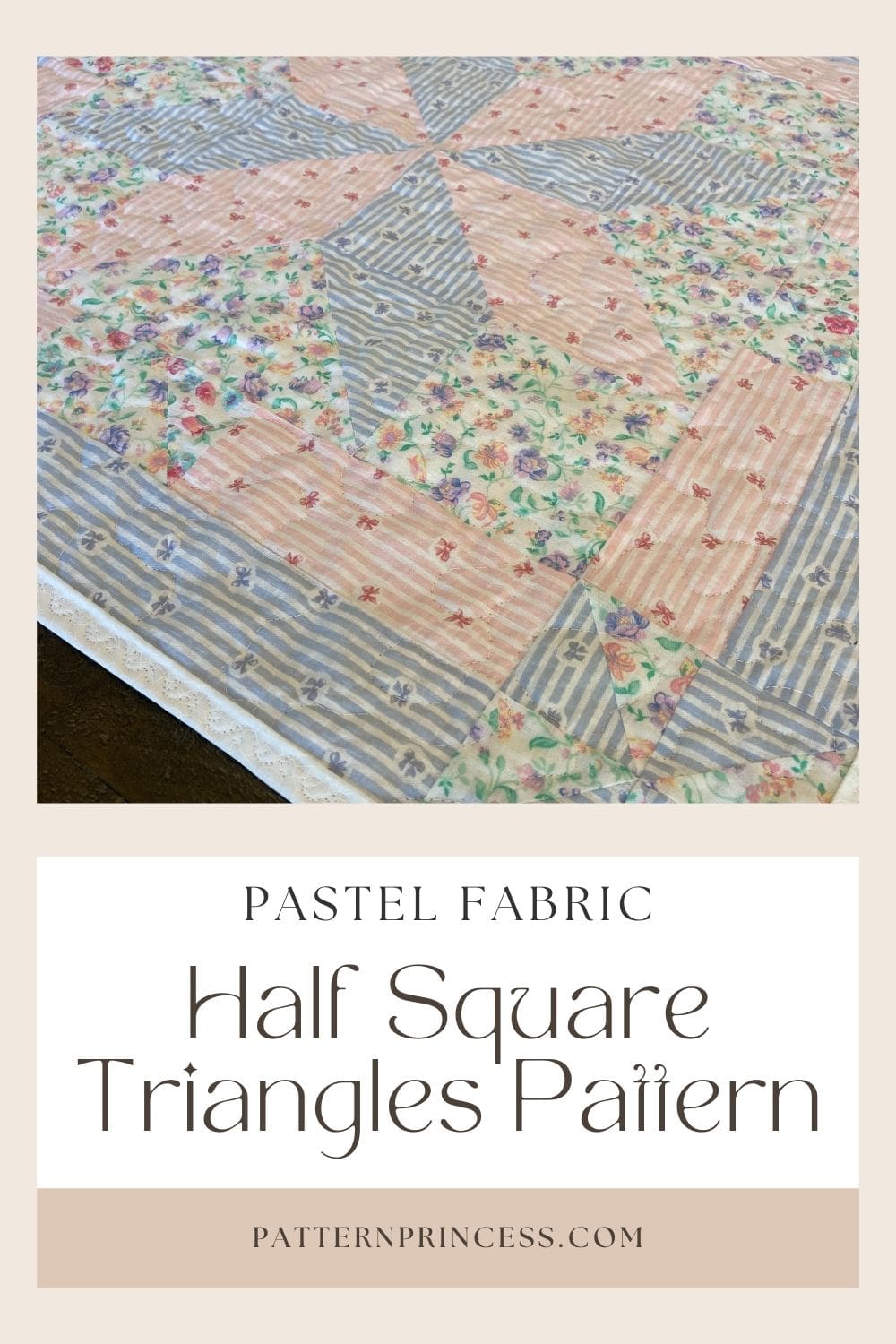
Prepare the Tablecloth Back, Binding, and Batting
Tablecloth Back fabric. Use a fabric that measures 28” X 28”. This will allow for approximately 4-inches of fabric to extend all around the edges of the tablecloth top.
Binding. You will need 114-inches of binding. Plan on approximately 1/2 of a yard. To make your own binding, cut 2 ½ strips of fabric. Mark one of the ends of each strip at apposing 45-degree angles.
Take the binding strips and sew them together aligning the 45-degree ends. Trim at 1/4”. Press the seams open.
Fold the binding strip in half with the wrong sides together and press.
Batting. Use a thin cotton batting such as warm and natural. Trim the batting to measure 28” X 28”, the same size as the quilt back. This will allow the batting to also extend beyond the edges of the tablecloth top.
Pin the Layers Together
Now it is time to make the quilt sandwich. This is the term that is often used to describe placing the backing fabric on the bottom, the batting in the middle, and the top decorative fabric on the top.
On a large surface, place the backing fabric right side facing down. Use masking tape or painter’s tape to tape the backing fabric down. Making sure to smooth out any wrinkles, yet not stretching the fabric.
Next lay the batting over the backing fabric. Again, smooth out any wrinkles.
Finally, place the quilt top fabric on the top with the right side up. Center the top fabric in the middle of the two bottom layers making sure that a few inches extend out beyond the quilt top on all sides.
Once all three layers are in place, make sure to smooth out any wrinkles. Use stainless-steel safety pins to base the quilt layers together. Place one pin every 4-5 inches.
Quilting the Layers Together
While you can sew the layers together by hand, I prefer to use my sewing machine for quilting the layers together. Once you choose your design, set up your sewing machine for quilting by using a darning foot and dropping the feed dogs on the sewing machine. This will allow you to free motion quilt your design.

Trimming the Batting and Backing Fabric
Trim the batting and backing fabric to 1/4″ from the edge of the quilt top. I use a ruler and rotary cutter to complete this.
Binding the Quilted Tablecloth
Once the layers are quilted, it is time to add the binding strip to the quilt.
Sew Binding onto the Quilt
Pin the raw edge of the binding onto the bottom quilt fabric edge. I generally start in the middle of a side. Leave approximately a 5” tail hanging. This hanging part will be used to sew to the other end of the binding strip when you have finished sewing all four sides of the tablecloth quilt.
Sew the binding onto all four sides of the tablecloth quilt making sure to miter the corners.
Mitering the Corners
To miter the corners, stop 1/4 inch from the corner. Use a ruler and pencil to make the location on the binding. Once you reach the 1/4 inch mark, turn your square and just sew a few stitches right off the corner. Trim your thread, not the binding strip though.
Folding the Mitered Corner
Fold the binding strip away from the direction you were just sewing at a 45° angle. Then fold the binding strip back down upon itself and match it to the edge of the square that you just sewed making sure that aligns with the raw edge of the next side that you will be sewing.
Begin stitching at the edge using the same 1/4 inch seam allowance. Repeat this process for the next 3 corners.
Connecting the Binding Ends
Stop stitching approximately 4” from the side where you started. Complete a few backstitches and snip the thread, not the binding. Remove the quilt from the sewing machine so you can join the two tails of the binding.
To join the tails so there is a continuous strip of binding to finish sewing down on the quilt edge. Measure the amount of binding that is needed to finish the quilt edge, plus 1/4″. Cut a straight line on each of the binding edges the making sure to correctly measure the amount that is needed yet. With the right sides together, sew the ends together with a 1/4” seam allowance. Now you can continue to sew the binding onto the quilt.

Attaching the Binding to the Front Fabric
Fold the binding over the edge, this will be the folded edge of the binding strip. Use a decorative or straight stitch to sew the binding strip to the front fabric. For each corner make sure to make a mitered corner and add a few extra stitches to hold it securely.
Washing your Quilt
When washing my quilts, I like to use a few color catchers in the wash. This will help ensure that all the colors stay crisp, and nothing bleeds onto the next color.
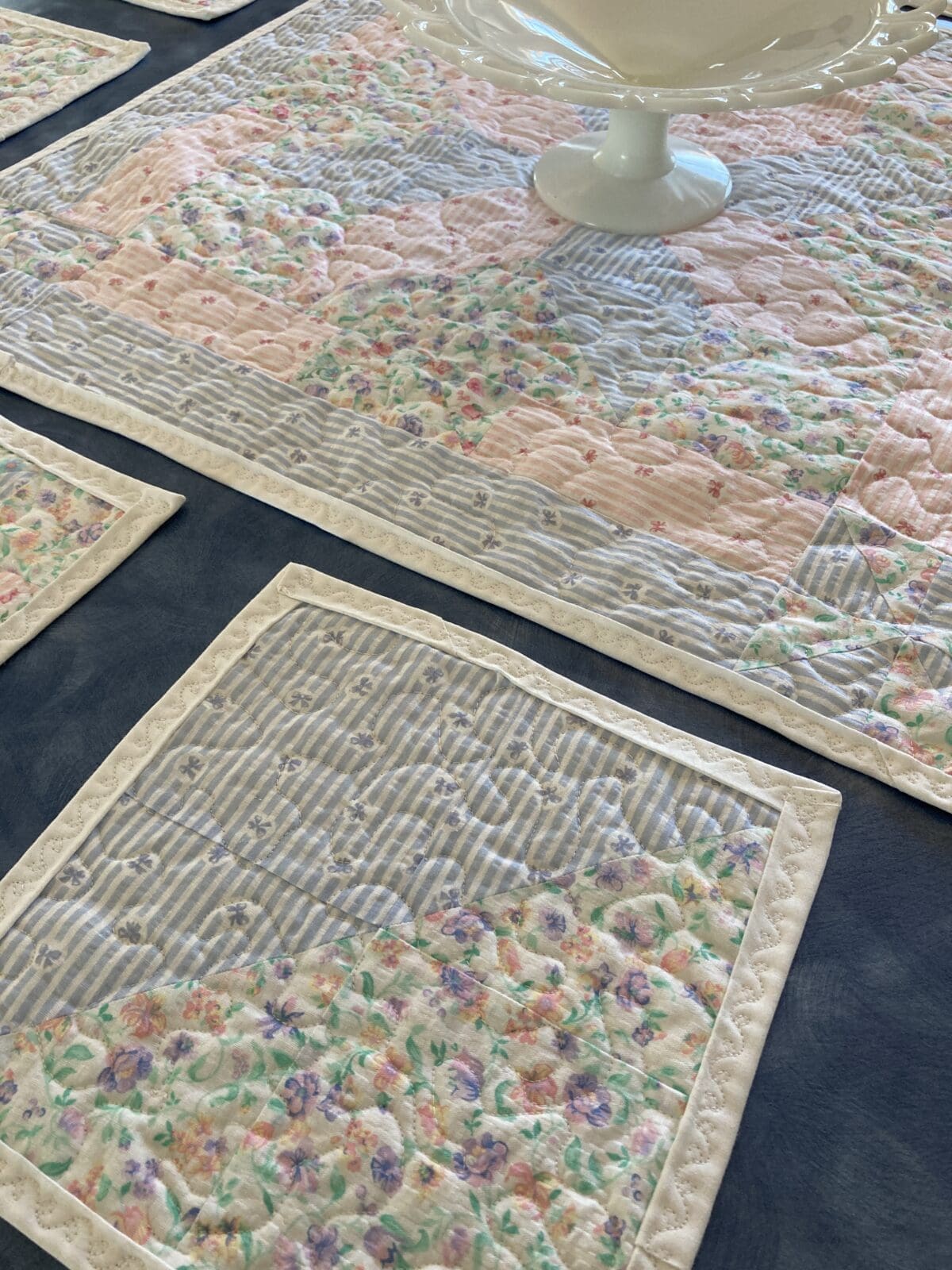
The entire Charming Pastel Tablecloth and Mini Quilt Patterns Set
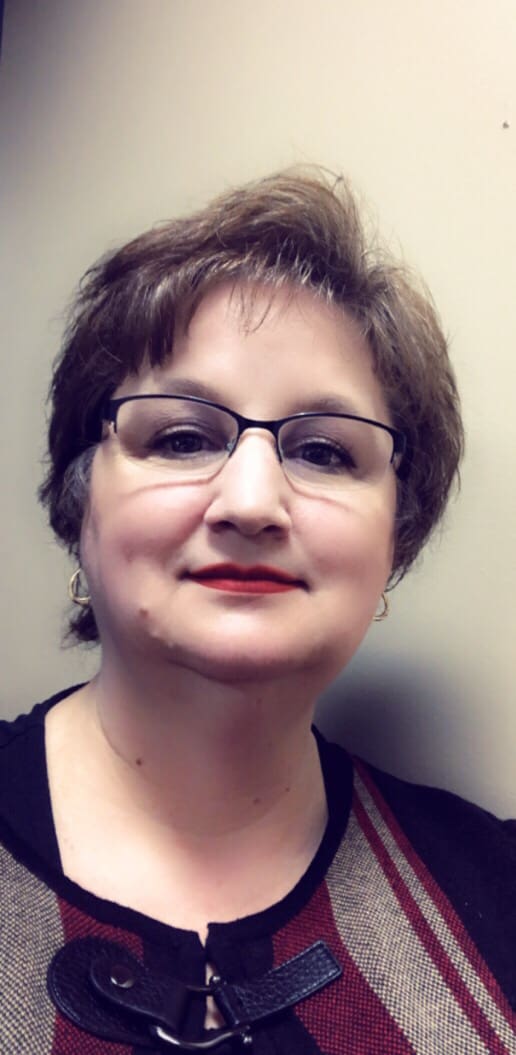
You can find Victoria crocheting, quilting, and creating recipes. She has cooked in restaurants for over 20 years, including many larger parties. She learned to crochet when she was just 11 years old and has been crocheting ever since; over 50 years now. Over 40 years ago, she loved her first class in sewing and continues to hone her skills in quilting. Many have enjoyed the handmade gifts over the years. In her professional career, she has worked in management in a wide variety of businesses including higher education as a dean of a division. All the while attending college part-time to achieve her doctorate in higher education with an emphasis in e-learning.
